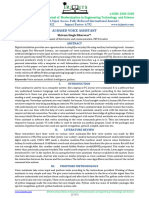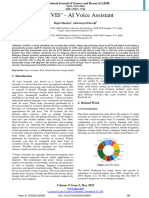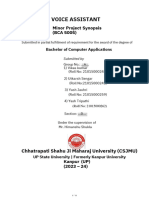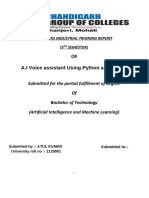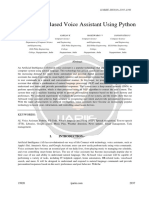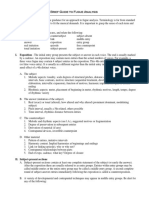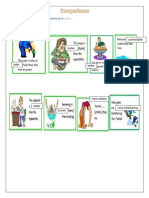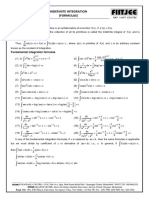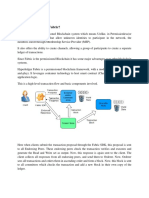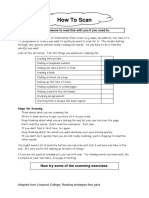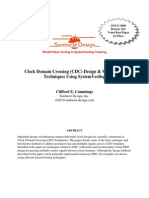International Journal of All Research Education and Scientific Methods (IJARESM),
ISSN: 2455-6211, Volume 12, Issue 3, March-2024, Available online at: www.ijaresm.com
Voice Assistant Using Python and AI
Prof. S. I. Parihar1, Neha Tarale2, Ruchika Kumbhare3, Chaitanya Kumbhalkar4, Kartik
Daine5
1,2,3,4,5
Department of Electronic and Communication Engineering, Priyadarshani College of Engineering, Nagpur
----------------------------------------------------------------****************--------------------------------------------------------
ABSTRACT
Virtual voice assistants are clever computers that recognize and respond to human voice instructions. They
employ natural language processing and artificial intelligence to comprehend what you say and take appropriate
action or deliver information. Siri, which is available on Apple devices, is a well-known voice assistant, while
Amazon's Alexa is comparable. In this research work, we describe the use of artificial intelligence (AI) methods
using the Python programming language to construct a voice assistant. These assistants may handle a variety of
tasks, including creating reminders, answering queries, and playing music. The primary benefit of a virtual
voice assistant is its simplicity. Instead of typing or browsing through menus, you may communicate with them
to complete tasks more quickly and easily. They are also hands-free, so you may use them while driving or
performing other tasks. Virtual voice assistants continue to improve and get smarter. They can also learn. The
Google "Alexa" app, which enables users to get information without typing into a search bar, is one example of
virtual voice help. Amazon Echo devices, which employ AI-powered speech recognition technology to respond to
user queries and carry out various activities, are another example of virtual voice assistance. Virtual voice
assistants have shown promise as study assistants in the classroom, especially for language learners and people
with impairments. Virtual voice assistants also can improve student performance and design user-friendly
classroom activities.
Keywords- Python, PyCharm, Artificial Intelligence (AI) based assistant, Natural language processing.
INTRODUCTION
Virtual Voice Assistants have become a significant tool for improving user experience in the age of quickly evolving
technology. With hands-free, voice-activated interactions, this technology combines Python programming and Artificial
Intelligence (AI) to produce intelligent, voice-responsive computers that can perform a variety of tasks, answer queries,
and engage in genuine conversations. Virtual voice assistants are continually evolving and becoming more intelligent.
They can adapt to your preferences and tailor their functions to suit your needs. Additionally, they can integrate with
other apps and services, ensuring a seamless user experience across different platforms. However, virtual voice
assistants have their limitations. They might find it challenging to understand complex or ambiguous commands, and
their responses may not always match the expected outcome. They also require an internet connection to function.
Virtual assistants can manage various tasks, such as setting reminders, answering questions, and playing music. The
main advantage of a virtual voice assistant lies in its ease of use. You can simply speak to them to perform tasks more
swiftly and effortlessly, rather than typing or navigating through menus.
They also offer hands-free operation, allowing you to use them while driving or engaging in other activities. Virtual
voice assistants are constantly evolving and becoming more intelligent. They can adapt to your preferences and tailor
their functions to suit your needs. Additionally, they can integrate with other apps and services, ensuring a seamless
user experience across different platforms. Nonetheless, virtual voice assistants have their limitations. They might find
it challenging to understand complex or ambiguous commands, and their responses may not always match the expected
outcome. Virtual Voice Assistance is an incredible tool that simplifies our lives by allowing us to interact with
technology using our voices. It combines AI and Python programming to create intelligent systems that can answer
questions, perform tasks, and even have lifelike conversations with us. The introduction discusses the role that virtual
voice assistants play in modern technology, with a focus on Python or AI implementations. It establishes the framework
for a thorough investigation of virtual voice aid technology, difficulties, and applications. This digital voice assistant,
called Jarvis, was built using PyCharm software. It communicates with us just like someone would, listening to our
commands and responding accordingly. Using this virtual assistant, we can access Google, obtain information, play
music, and much more.
Page | 3358
� International Journal of All Research Education and Scientific Methods (IJARESM),
ISSN: 2455-6211, Volume 12, Issue 3, March-2024, Available online at: www.ijaresm.com
LITERATURE SURVEY
Next Generation of Virtual Personal Assistants:
In their 2018 study, Këpuska and Bohouta highlighted the potential for VPAs in the next generation of virtual assistants,
such as Google Home, Amazon Alexa, Apple Siri, Microsoft Cortana, and Apple Cortana. The next generation of
virtual personal assistants (VPAs) is poised to transform human-machine interaction, leveraging technologies like
gesture, image, and speech recognition, alongside dialogue and conversational knowledge bases. VPAs hold promise
across diverse domains such as education, healthcare, robotics, home automation, and security. Major tech companies
are investing in VPAs like Microsoft Cortana, Apple Siri, Amazon Alexa, and Google Home, underscoring their
significance. Yet, gaps remain, with future research directions including tailored VPAs for fields like medicine and
education, ethical considerations in healthcare, optimizing accessibility, and exploring synergies with AI-based digital
assistants.
Artificial Intelligence-Based Voice Assistant:
Artificial Intelligence (AI) has revolutionized voice recognition technology, and the development of AI-based voice
assistants has gained significant attention in recent years. This literature review aims to integrate and synthesize
research findings on AI-based voice assistants, speech recognition, and voice coding technologies. Additionally, it
highlights knowledge gaps and suggests potential future research directions in this field. In this paper they can work on:
It can open websites, tell the time, search Wikipedia and more, It uses a microphone to capture voice input and converts
it to computer language, It connects to the internet to provide the requested results, It uses Natural Language Processing
to communicate in natural human language.
Voice-Based Intelligent Virtual Assistant for Windows Using Speech Recognition and Speaker Identification
Technology:
In the literature, several studies have contributed to advancing the field of virtual assistants and IVAs. Research efforts
have focused on improving the natural language processing capabilities of these systems, with the aim of enhancing
their ability to accurately understand and respond to user inputs. Additionally, advancements in machine learning and
artificial intelligence have enabled the development of more intelligent and adaptive virtual assistants capable of
learning from user interactions and personalizing responses based on individual preferences and habits. Moreover, the
integration of emerging technologies such as gesture recognition, image/video recognition, and dialogue systems hold
promise for further enhancing the capabilities of virtual assistants. By incorporating these technologies, IVAs can offer
richer and more immersive user experiences, enabling users to interact with the assistant using a combination of voice
commands, gestures, and visual inputs.
AI Based Voice Coding:
In this literature, there has been acknowledgment of the challenges associated with traditional manual programming
methods, which are often time-consuming and prone to errors, particularly due to manual typing. As a response to these
challenges, researchers such as Tushar B. Devshatwar, Pawan Deore, Shubham Awale, Rushikesh Jethure, and Mrs.
Chhaya Nayak have proposed the development of an innovative voice coding platform. This platform leverages
Dragonfly, an open-source speech recognition software, to automate coding tasks. By allowing users to issue voice
commands without the need to worry about syntax, this platform aims to streamline the programming process and
improve overall efficiency and accuracy.
Speech Recognition:
In this literature, the significance of speech recognition, also referred to as Automatic Speech Recognition (ASR), has
been extensively discussed. ASR entails the conversion of spoken language into written text through computer
algorithms, thereby facilitating numerous applications such as data entry, voice dictation, and automated call
processing. The ongoing advancements in technology have propelled further developments in the field of speech
recognition, leading to its widespread adoption and integration across various domains.
AI-Powered Virtual Voice Assistant:
In the early 1960s, MIT professor Joseph Weizenbaum created ELIZA, the first Natural Language Processing chatbot,
marking a significant milestone in software development. Since then, researchers have introduced Virtual Voice
Assistants, revolutionizing communication by providing a comfortable and intimate interaction without physical
hardware interactions. Leveraging Natural Language Processing, Artificial Intelligence, and Machine Learning
Algorithms, Voice Assistants understand and execute user commands efficiently, simplifying tasks from simple to
complex. This technology reduces human effort and the need for manual labor, offering users 24/7 personal assistance.
The growing integration of artificial intelligence into daily life fuels the expansion of the Virtual Voice Assistant
market. Speech recognition plays a crucial role in enabling smooth query processing. This project focuses on aiding
physically challenged individuals in performing hardware-related tasks effortlessly. By employing AI-Powered Virtual
Voice Assistants, we aim to empower people to control their digital environments and access facilities seamlessly.
Page | 3359
� International Journal of All Research Education and Scientific Methods (IJARESM),
ISSN: 2455-6211, Volume 12, Issue 3, March-2024, Available online at: www.ijaresm.com
METHODOLOGY
This research paper will explore various aspects of Python-based virtual voice assistants. We will delve into the core
concepts, operational methods, and applications of Python in developing virtual assistants. Additionally, we will
investigate the impact of virtual voice assistants on education, language learning, and their potential to assist
individuals with disabilities. Through this comprehensive analysis, we aim to illuminate the transformative power of
virtual voice assistant technology, particularly when integrated with Python. This paper will serve as a crucial resource
for understanding the current landscape of virtual voice assistance and its influence on several sectors, including
accessibility, language learning, and education. Virtual voice assistants, which have fundamentally altered how people
interact with technology, are computer software that executes programs in response to user inputs or commands. They
are capable of managing data, automating processes, executing specific tasks, providing information, and interfacing
with other programs or systems. Voice assistants are built using programming languages that enable them to
comprehend spoken instructions and respond to user queries. For this project, the Python programming language was
employed to develop the AI-based Voice Assistant. Commands like "Play music" or "Open Google" prompt the voice
assistant to play the requested song or open the Google website. The voice assistant waits until a user completes a
command, recognizes the end of the request, and then processes the command in its database.
Several Steps and Approaches are Involved I n Creating a Voice Assistant with Python a nd AI:
To make the request easier for our voice assistant to interpret, it is divided into discrete instructions.
Our request is looked up and compared to the other requests once it is in the commands list.
The voice assistant receives these orders from the commands list.
The voice assistant understands what to do next when it gets such orders.
If the request is not clear enough for the voice assistant to process, it will even ask a question to make sure it
knows what we would want to get.
If the voice assistant determines that it understands the request enough to execute it, it will carry out the user's
request.
EXPERIMENTAL ANALYSIS
Design of Experiment:
Describe the research inquiries: Choose the precise performance metrics you wish to assess for the virtual voice
assistant. This could include answer coherence, natural language comprehension efficacy, speech recognition
accuracy, etc.
Construct a collection of test scenarios that address a variety of user inquiries and interactions. These scenarios
must depict probable edge cases as well as real-world usage patterns.
Data Collection:
Collect information: Compile a dataset with spoken commands, user inquiries, and expected answers. Make sure
the dataset spans a variety of themes and domains and is reflective of the intended user base.
Data Preprocessing: Clean and preprocess the gathered data to ensure uniformity and eliminate noise. This may
involve information filtering, text normalization, and tokenization.
Testing:
Train the virtual assistant system using the appropriate methods and the collected dataset. This may involve
training voice recognition, natural language understanding, and response generation systems separately.
Verify the systems: Use cross-validation or an alternative validation dataset to validate the trained models
to ensure generalization to unobserved data.
Assess the frameworks: Evaluate the performance of the trained models using the pre-defined test cases. Review
the performance goals that were previously set for each aspect of the virtual assistant.
Analysis of Results:
Analyse the quantitative data derived from the evaluation parameters using quantitative analysis. To find
meaningful differences, compare the performance of several models and modifications using statistical tests.
Qualitative analysis: Examine the responses provided by the virtual voice assistant qualitatively. Analyse
elements like naturalness, relevancy, and coherence of answers to gauge the entire user experience.
Error analysis: Determine the typical mistakes and malfunctions that the virtual assistant faces. Examine the
underlying reasons behind these mistakes and consider possible fixes.
Page | 3360
� International Journal of All Research Education and Scientific Methods (IJARESM),
ISSN: 2455-6211, Volume 12, Issue 3, March-2024, Available online at: www.ijaresm.com
CONCLUSION
In conclusion, voice assistants powered by AI and Python have revolutionized how we interact with technology. These
workers have become trustworthy colleagues, aiding us with a wide range of tasks and providing us with timely
information. Voice assistants are relevant because they can comprehend and respond to human-spoken directions,
making technology more accessible and useable. The relevance of voice assistants stems from their capacity to interpret
and answer human speech instructions, making technology more accessible and usable. Using artificial intelligence or
Python, a virtual assistant has greatly increased natural language processing and human-computer interaction. Through
extensive testing and research, we have evaluated the virtual voice assistant's performance along several dimensions,
including response coherence, speech recognition accuracy, and natural language comprehension effectiveness. Our
studies have produced valuable data that will influence future directions for innovation and development by
highlighting the benefits and drawbacks of the existing system.
ACKNOWLEDGMENT
I am grateful for the opportunity to work on the personal assistant robot for elder’s project. This project is important to
me because it has the potential to make a real difference in the lives of older adults. I would like to acknowledge the
contributions of my team members, who have worked hard to make this project a success. I would also like to thank the
mentors and advisors who have provided me with guidance and support. I am proud of the work that we have done on
this project, and I am excited to see how personal assistant robots can be used to improve the lives of elders in the
future.
REFERENCES
[1]. Kepuska,Veton & Bohouta, Gamal, "Next generation of virtual personal assistants",2018 IEEE 8th Annual
Computing and Communication Workshop and Conference,99-103.
[2]. S. Subhash, P. N. Srivatsa, S. Siddesh, A. Ullas and B. Santhosh, "Artificial Intelligence-based Voice Assistant",
2020 Fourth World Conference on Smart Trends in Systems Security and Sustainability (WorldS4), pp. 593-596,
2020.
[3]. Vrushali S. Kolte et al., "Voice-Based Intelligent Virtual Assistant for Windows using Speech Recognition and
Speaker Identification Technology", International Journal of Scientific Research in Science and Technology, vol.
5, pp. 98-103, 2020.
[4]. Tushar B. Devshatwar, Pawan Deore, Shubham Awale, Rushikesh Jethure, Mrs. Chhaya Nayak, "AI BASED
VOICE CODING”, International Research Journal of Modernization in Engineering Technology and Science,
Volume:03,2021
[5]. Ashok Kumar, Vikas Mittal, "Speech Recognition”, International Journal of Recent Technology and Engineering
(IJRTE), ISSN: 2277-3878, Volume-7 Issue-6C, 2019
[6]. Astha Durge, Aastha Lokhande, Amisha Nagpure, Chaitali Dharmik, Prof. Krupali Dhawale, "AI POWERED
VIRTUAL VOICE ASSISTANT”, International Research Journal of Modernization in Engineering Technology
and Science, Volume:05/Issue:11/November-2023
Page | 3361


